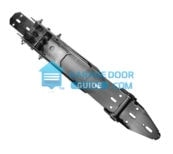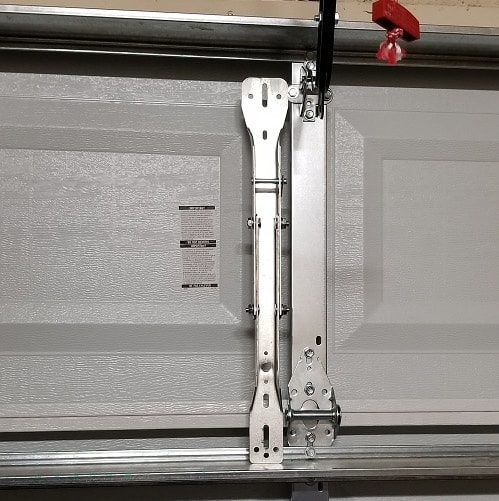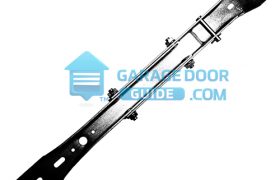Reinforce Your Garage Door In 3 Easy Steps
All garage doors should be reinforced with an opener attachment mounting bracket and horizontal cross braces called struts. These parts help prevent overhead door panels from bowing, cracking and splitting.
My first home purchase included a garage door that was so flimsy it seemed like a strong gust of wind would blow it right onto my car at any moment. Seeing this clunker of a garage door popping in action forced me to think of ways I could reinforce the door, saving myself a trip to the auto body shop. Fortunately for me I ended up taking a job in the door business soon after and received some great advice. In this post I will share with you the reasons garage doors need reinforcement, how to reinforce the door and why it makes economic sense to take preventative measures.
Why Reinforce Your Garage Door?
The combination of heavy usage and large surface area can make garage doors a weak point on your home. On top of that most people use the garage door as the main entry way to their house, adding up to 1,000 cycles in just one year! The outer surface area doesn’t help either with double doors having over 100 sq ft exposed to wind, hail and kids sports equipment – just for starters. Winter climates are particularly hard on garage doors. The combination of snow, ice, wind and hail can severely damage weak garage doors. Often times your weather-seal on the bottom of the overhead door will freeze to the surface below. When the automatic opener is ran it attempts to lift a frozen door, causing the top section to rip apart. Reinforcements are a cost effective way to increase the longevity and performance of your garage door.
Reinforcing An Existing Door
If you already have a door installed there are steps you can take to reinforce your existing door. The top section of your garage door is under the most stress since it likely has an automatic opener attached to its center stile pulling and pushing during door operation. The bottom section is also under a lot of stress since the torsion spring system tension is being directed through the bottom corner brackets. The bottom section also sits closest to the ground and makes hard contact with the ground if manually operated.
During my time as a service coordinator at least 75% of damaged panel house calls involved the top section. Due to the high percentage all top sections on garage doors should have horizontal and vertical reinforcement.
- Opener Reinforcement Bracket (vertical)
- Struts & Punch Angle (horizontal)
Top Panel Garage Door Opener Bracket Reinforcement
The first step in reinforcing your garage door is to install a garage door opener reinforcement bracket. Obviously if you plan on manually raising your door by hand without the use of an automatic opener you will not need this bracket. Most garage door openers include a small opener bracket that anchors to the top panel center style. Unfortunately, this bracket does not evenly distribute the force of the opener pulling the garage door. This creates a situation where excess tension can rip the center style off of your garage door, damaging the top section – especially during winter months when ice can freeze the bottom section to the floor.
An OEM adjustable operator reinforcement bracket can be installed on the top panel of your door to prevent the center style from separating from the base of the door panel. The bracket is installed the full length of the center style of your garage door to distribute the opener tension equally across the full height of the door stile. Opener brackets come in a variety of styles, colors and sizes to fit all types of doors. The opener bracket shown in the picture is a universal narrow adjustable bracket that can be adjusted to door sections measuring 18″ – 24″ in height. It also has a narrow low profile design to blend in with the garage door stiles it anchors to. For these reasons I believe it is the best option for all residential garage door opener reinforcement.
- Narrow Adjustable Zinc Plated
- Narrow Adjustable Powder Coated White
- Wide Body Adjustable Full Hinge Zinc Plated
- Wide Body Adjustable Half Hinge Zinc Plated
- Wayne Dalton Adjustable Bracket
Narrow Adjustable Reinforcement Bracket
The most economical way to reinforce your garage door for the use of an automatic opener is with the narrow adjustable opener mounting bracket. Its sleek professional design is strong enough for all residential and light duty doors. The zinc plated finish helps it blend in with the center stile it attaches to. In the event you have a double sided steel garage door with white interior, a white powder coated finish is available. The bracket has a 12 gauge thickness and comes with 4 adjustable settings accommodating doors from 18″-24″ in height. This particular bracket doesn’t come with a built-in hinge so both your top strut and #1 hinge will need to be fastened. The narrow adjustable bracket is the the best choice for residential garage doors.
Wide Body Reinforcement Bracket
For doors requiring a more heavy duty option, wide body adjustable brackets are suitable. These brackets are also 12 gauge zinc plated steel and can handle the stress of heavy wood and commercial size doors. The
- Wide Fixed Height Brackets (20″ , 21″ 24″)
- Wide Adjustable Full Hinge
- Wide Adjustable Half Hinge
Wayne Dalton Bracket
Certain manufacturers have unique door designs that will not accept the traditional reinforcement bracket options discussed above. One such brand is Wayne Dalton, which lacks an extruding center stile anchor point.
A garage door opener does not need to mount to the exact center stile of the garage door provided that a torsion spring system is being used. Garage door openers can be mounted slightly off-center to avoid obstructions on the ceiling. If you need to mount the opener directly to the center of the door but the door doesn’t have a center stile you can build an “H” bracket. The “H” bracket is constructed by running two pieces of punch angle horizontally and one vertically down the center making a sideways letter H. This provides a secure anchor point for the opener “J” arm to connect to.
Installing Opener Reinforcement Brackets
- Figure out what type of opener bracket you need – narrow or wide? Zinc plated or white? Adjustable brackets are highly recommended.
- Close your garage door and unplug your garage door opener.
- Disconnect your operator “J” arm from the opener bracket by removing the pin.
- Remove the existing bracket, center hinge and strut (if on the top section)
- Measure your top section height & put together the opener bracket to match using bolts, screws, and clevis cotter pins supplied.
- Fasten the opener bracket to the center stile with at least 4 self drilling TEK screws.
- Reinstall the center hinge over the bottom of the opener bracket.
- Reinstall any struts or punch angle over the opener bracket using the existing screws.
- Connect the opener J arm to the cotter pin and secure the clevis pin.
- Plug in and run your garage door opener.
Horizontal Strut Reinforcement Bracing
In addition to a vertically installed opener bracket a horizontal strut should also be installed. Horizontal struts also known as braces and bars are available 2″ and 3″ heights. They are commonly stock in 9ft-18ft lengths, but can be ordered up to 30ft long. They are installed on the interior of the garage door and screw into to each metal style location. Every garage door should have a strut installed on the top section. An operator reinforcement bracket and strut combination is the best way to reinforce your garage door. This is especially important for doors using an automatic garage door opener. If you manually open and close your garage door you will not need an opener reinforcement bracket since there is nothing pulling on the top section.
How Many Struts Should Be Installed?
Horizontal struts can be installed on every section of the garage door. Some doors have a strut installed on the top and bottom of each panel. This is common in coastal areas where garage doors must be wind code rated due to tropical storms with winds exceeding 100 miles per hour. If you decide to add additional struts to an existing door it is important to remember that you may need to adjust the spring tension or replace the springs entirely. Adding more than 10 lbs of weight to your door usually requires additional tension to be added to your torsion springs and if you have to add more than a full turn of tension to the torsion springs it is probably best to completely replace them with a properly calibrated set. Adding excess tension to your springs will cause them to wear out much faster!
Getting your door reinforced during the purchasing process is MUCH easier than retrofitting a door already installed. If you suspect your garage door will take on a lot of abuse get it reinforced correctly before purchase. Reinforcing a door with an opener bracket and horizontal struts can cost 3x more if not done during the initial purchase. Special applications require a higher reinforcement package. Here are a few applications that come to mind:
- Oil Change Centers
- Doors Where Children Play Sports
- Mini Storage Facilities
- Pole Barns Experiencing High Winds
It may be easier to reinforce your door right from the start. During the buying process you can request that your garage door dealer automatically include a strut on every section of your door and include the corresponding springs. This request will come at a higher cost than a base hardware package, but will save you money in the long run by preventing your garage door from being damaged.

Eliminate Popping Noises With Reinforcement Struts
Older garage doors may have sections that are prone to sagging, warping and bending. When a wide door sags in the middle the tongue and groove joints of each section may not line up correctly, causing the tongue to rub against the groove as the door is moving. This usually results in a popping noise as the joint “pops” into place. Many homeowners report popping noises as the door moves around the curved track radius although it can happen at any point during operation. Adding a horizontal support strut will help prevent the door from sagging in the middle and allow the joints to line up correctly during operation.
If your garage door is already bent, cracked or split horizontal bracing is a temporary solution. Bracing can be added to the damaged area to keep the panel from separating. However, the damaged section will need to eventually be replaced. Much like an aluminum soda can being bent back and forth the garage door section will eventually split and break in half. This can cause damage two other sections of the garage door or personal property in the garage. Punched angle can be added in the area where the door is split or cracked. This will serve as a temporary fix until the section can be properly replaced.
Reinforcement Before An Approaching Storm Or Hurricane
Garage doors are prone to damage during storms due to the high surface area on the face of the door. This is especially true for garage doors installed on pole barns and buildings where the pressure inside the structure can change drastically. Storms can actually produce negative pressure causing the door to be blown outward instead of being pushed in. The higher the surface area of your door the greater the chance of damage occurring during a storm.
Special vertical storm bracing kits are available that can be installed on the interior face of the door. instead of horizontal struts which goes side to side garage door storm kits have braces installed vertically down the center of the door attaching from the bottom of the door to the header.If you do not want to buy the professional storm reinforcement kit a rigid piece of lumber can be installed. If you intend to leave your vehicle in the garage during a storm, you can back the vehicle right up to the garage door so that your bumper pressing the board against the door. It is advisable that you unplug your garage door opener when installing the storm bracing as this will prevent somebody from operating the door during installation and also prevent you from running your opener with the bracing still installed causing damage to your opener.
What will Garage Door Reinforcement Cost?
Garage door reinforcement is a cost effective way to prevent damage to your garage door – considering new door panel replacement starts in the hundreds of dollars. Opener attachment reinforcement brackets range and price from $20 up to $30 depending on the style and size. Horizontal struts and perforated angle iron can be found at your local garage door dealer or hardware store for around $2 per ft. Self drilling screws can be found in small boxes for under $5. The work is easily done by most homeowners in under 30 minutes eliminating an expensive service charge. Hiring a garage door professional to do the work can be costly. Most door reinforcement service calls cost around $100-$200, depending on the work required and local market.
- Average Service Rate $75
- Opener Bracket Cost $25
- Strut/Punch Angle Cost $2 per foot
Will Insulation Help Reinforce Garage Doors?
This really depends on the type of insulation your garage door has. Two types of insulation have drastically different contributions towards door reinforcement. Polystyrene foam panel insulation may be great for energy efficiency, but does little to reinforce your garage door. In fact, as the styrofoam panels age they can begin to absorb moisture contributing to panels sagging in the middle due to the increased weight.
On the other hand, polyurethane injected insulation drastically increases rigidity. Door manufacturers inject this type of insulation to the inner cavity of the door using foam in place, bonding it to the steel skin. Polyurethane insulation is significantly more dense than polystyrene which greatly reinforces the door structure. Lastly, urethane insulated doors usually have a protective interior steel skin. Polyurethane foam in place insulated doors are a superb choice for door reinforcement. This type of insulation must be ordered with a new garage door where as styrofoam insulation panels can be installed anytime.




